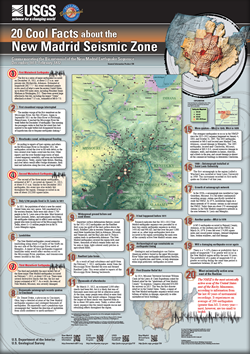Skip Links
General Information Product 134
20 Cool Facts about the New Madrid Seismic Zone
Commemorating the Bicentennial of the New Madrid Earthquake Sequence December 1811–February 1812

This poster summarizes a few of the more significant facts about the series of large earthquakes that struck the New Madrid seismic zone of southeastern Missouri, northeastern Arkansas, and adjacent parts of Tennessee and Kentucky from December 1811 to February 1812. Three earthquakes in this sequence had a magnitude (M) of 7.0 or greater. The first earthquake occurred on December 16, 1811, at 2:15 a.m.; the second on January 23, 1812, at 9 a.m.; and the third on February 7, 1812, at 3:45 a.m. These three earthquakes were among the largest to strike North America since European settlement. The mainshocks were followed by many hundreds of aftershocks that occurred over the next decade. Many of the aftershocks were major earthquakes themselves. The area that was strongly shaken by the three main shocks was 2–3 times as large as the strongly shaken area of the 1964 M9.2 Alaskan earthquake and 10 times as large as that of the 1906 M7.8 San Francisco earthquake. Geologic studies show that the 1811–1812 sequence was not an isolated event in the New Madrid region. The 1811–1812 New Madrid earthquake sequence was preceded by at least two other similar sequences in about A.D. 1450 and A.D. 900. Research also indicates that other large earthquakes have occurred in the region surrounding the main New Madrid seismicity trends in the past 5,000 years or so.
|
First posted September 30, 2011
This report is presented in Portable Document Format (PDF); the latest version of Adobe Reader or similar software is required to view it. Download the latest version of Adobe Reader, free of charge. |
Suggested citation:
Williams, R.A., McCallister, N.S., and Dart, R.L., 2011, 20 cool facts about the New Madrid Seismic Zone—Commemorating the bicentennial of the New Madrid earthquake sequence, December 1811–February 1812 [poster]: U.S. Geological Survey General Information Product 134.
Contents
First Mainshock Earthquake
First steamboat voyage interrupted
Riverbanks caved, widespread flooding
Second Mainshock Earthquake
Only 5,700 people lived in St. Louis in 1811
Landslides
Third Mainshock Earthquake
Homemade seismograph records quakes in Cincinnati
Widespread ground failure and sand blows
Reelfoot Lake forms
Thousands of aftershocks
It had happened before 1811
Archaeological age constraints on earthquake timing
First Disaster Relief Act
More quakes—M6.0 in 1843, M6.6 in 1895
1909—Seismograph installed at Saint Louis University
Growth of seismograph network
Another quake—M5.0 in 1976
Will a damaging earthquake occur again
Most seismically active area east of the Rockies